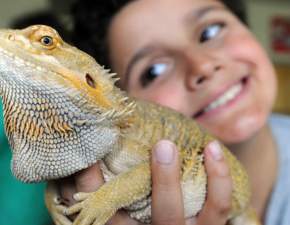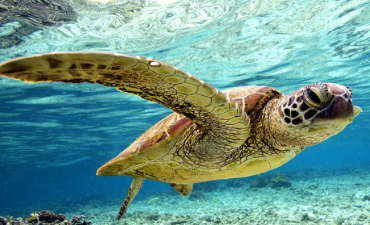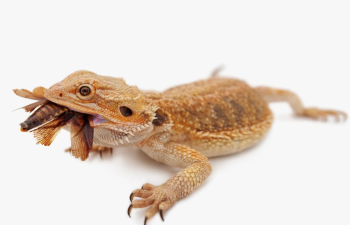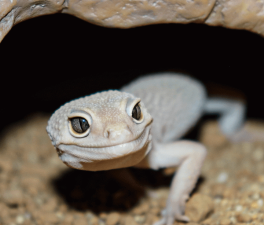Reptiles can also get sick, and improper temperatures or feed, or a suboptimal housing environment, can increase the risk of illness.

Reptiles can also get sick, and improper temperatures or feed, or a suboptimal housing environment, can increase the risk of illness.
Problems Caused by Improper Housing
- Heat Burns
Reptiles often seek out heat to maintain their body temperature. If a pet is kept in a walled room with an exposed light bulb, heating pad, or hot rock as the only source of heat, the pet may remain on the device and develop severe, life-threatening burns (Figure 2.19). These conditions should be considered emergencies and require appropriate treatment. In the case of severe burns, the pet may lose a large amount of fluid in the burn area, so adequate fluids should be replaced.
- Prey Bites
Reptiles and amphibians will only eat when they are hungry. Most pet owners give their reptiles and amphibians live food, assuming that the pet will actively eat, or at least kill, these small animals. Unfortunately, this is not the case. Many prey animals, including rodents and insects, will "attack" predators when they are not being noticed. There are many reports of large snakes dying from wounds caused by rats or rabbits. Even common crickets have been observed "feeding" on immature lizards.
Prey bites should be managed like infected wounds (see thermal burns). Owners should be advised of the dangers of feeding live prey and instructed to observe their pets while they eat. All mammalian prey (e.g., rabbits, mice) should be humanely euthanized before feeding reptiles.
- Ecdysis Disorders
As reptiles grow, they shed the outer layer of their skin. In immature pets, shedding (molting) occurs regularly and slows as they mature. Shedding of the skin is a normal and necessary behavior experienced by all reptiles; however, the pattern of molting varies from species to species. Turtles and lizards typically shed their skin in pieces, whereas snakes shed their skin in one piece. Although all reptiles can have molting disorders, most of the problems associated with molting (molting disorders) documented in the literature concern snakes. Causes of reptile molting disorders are related to low humidity and temperature, ectoparasites, traumatic wounds, systemic illness, abuse, and lack of an environment that supports molting.

Nutritional Diseases
- Secondary Nutritional Hyperparathyroidism
The most common nutritional disease in reptiles is secondary nutritional hyperparathyroidism (SNHP). SNHP can be caused by a calcium-deficient diet, a phosphorus-rich diet, or a lack of vitamin D. The disease process activates the parathyroid glands to release parathyroid hormone, which mobilizes calcium from the bones to meet the pet's daily needs. A thorough history will allow the veterinarian to make this diagnosis. Pets with SNHP are generally young, rapidly growing pets or reproductively active adult females. These females have abnormal ETRs (which slow metabolism) and/or diets that are deficient in calcium, high in phosphorus, or lack of exposure to ultraviolet B light (which helps synthesize vitamin D).
- Vitamin A Deficiency
Vitamin A deficiency is common in turtles that do not eat the right diet. These animals are typically young, growing rapidly, or have spent a long time in the wild as pets, inappropriate temperatures, and diets lacking vitamin A. Physical examination will reveal that these pets often have unilateral or bilateral eyelid edema (swollen eyelids), nasal and ocular discharge, diarrhea, pneumonia, ear abscesses, and hyperkeratosis.
Vitamin A deficiency causes changes in the lining of the respiratory tract, oral cavity, skin, and urothelial tract. This results in squamous metaplasia that reduces the tight junctions that form between cells, allowing opportunistic pathogens to enter. Diagnosis is usually based on history, physical examination findings, and treatment response. Pets with respiratory disease should have bacterial cultures and antimicrobial sensitivity testing to determine appropriate antimicrobial therapy to manage opportunistic infections.
- Gout
Gout is caused by the deposition of monosodium urate crystals into the viscera (visceral gout) or joints (articular gout) (Figure 2.20), which is the result of factors such as excessive uric acid production by the body (such as a high-protein diet), dehydration, or kidney damage. Pets with gout are usually adult animals that may be herbivores, omnivores, or carnivores. Generally, these pets are in good health but suddenly become depressed and lethargic. If you investigate the pet's feeding history, you can usually find that the pet is not fed the right food or is not getting enough water.



